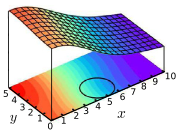AG — Prof. Heiko Rieger — Statistical Physics
Efficient kinetic Monte Carlo method for reaction-diffusion problems with spatially varying annihilation rates
Heiko Rieger, Karsten Schwarz,

We present an efficient Monte Carlo method to simulate reaction-diffusion processes with spatially varying particle annihilation or transformation rates. Like Green's function reaction dynamics and first-passage time methods, our algorithm avoids small diffusive hops by propagating sufficiently distant particles in large hops to the boundaries of protective domains. Since for spatially varying annihilation or transformation rates the single particle diffusion propagator is not known analytically, we present an algorithm that generates efficiently either particle displacements or annihilations with the correct statistics, as we prove rigorously. The numerical efficiency of the algorithm is demonstrated with an illustrative example.
The major disadvantage of studying diffusive processes with the help of random walks is the enormous number of needed small hops of a conventional random walker. The step-size of these hops has to be much smaller than the smallest length-scale of the investigated system, otherwise the results will mostly be wrong. Thus, classical random walks will become more and more inefficient, if there is a large gap between the smallest and the largest length-scale of the system, as the walker will need a huge number of steps to move on the largest scale. Green’s function reaction dynamics (GFRD) ([2, 3]) and first-passage kinetic Monte Carlo (FPKMC) methods overcome this bottleneck by ([4–6]) generating stochastically on average much larger displacements according to the exactly known Green’s function for a freely diffusive particle within so-called protective domains. Since the particle diffusion propagator within these protective domains is only known for a homogeneous annihilation rate, it is not obvious any more how to include a spatially varying annihilation rate. Nevertheless, it is possible to solve this problem efficiently by using the propagators of the homogeneous case. [1] is showing this by presenting an efficient Monte Carlo method for simulating reaction-diffusion processes in arbitrary two- and three-dimensional domains with spatially varying annihilation rates.
| Efficient kinetic Monte Carlo method for reaction-diffusion problems with spatially varying annihilation rates |
|
| J. Comp. Phys. 237, 396 (2013) | [pdf], [cond-mat] |
| Simulating biochemical networks at the particle level and in time and space: Green’s
function reaction dynamics, |
|
| Phys. Rev. Lett. 94, 128103 (2005) | |
| Green’s function reaction dynamics: A particle-based approach for simulating biochemical
networks in time and space, |
|
| J. Chem. Phys., 123, 234910 (2005) | |
| First-passage Monte Carlo algorithm: Diffusion
without all the hops, |
|
| Phys. Rev. Lett., 97, 230602 (2006) | |
| First-passage kinetic Monte Carlo method, |
|
| Phys. Rev. E 80, 066701 (2009) | |
| A First-Passage Kinetic Monte Carlo
algorithm for complex reaction-diffusion systems, |
|
| J. Comp. Phys. 229, 3214 (2010) | |
Legal notice (Impressum) Privacy policy



